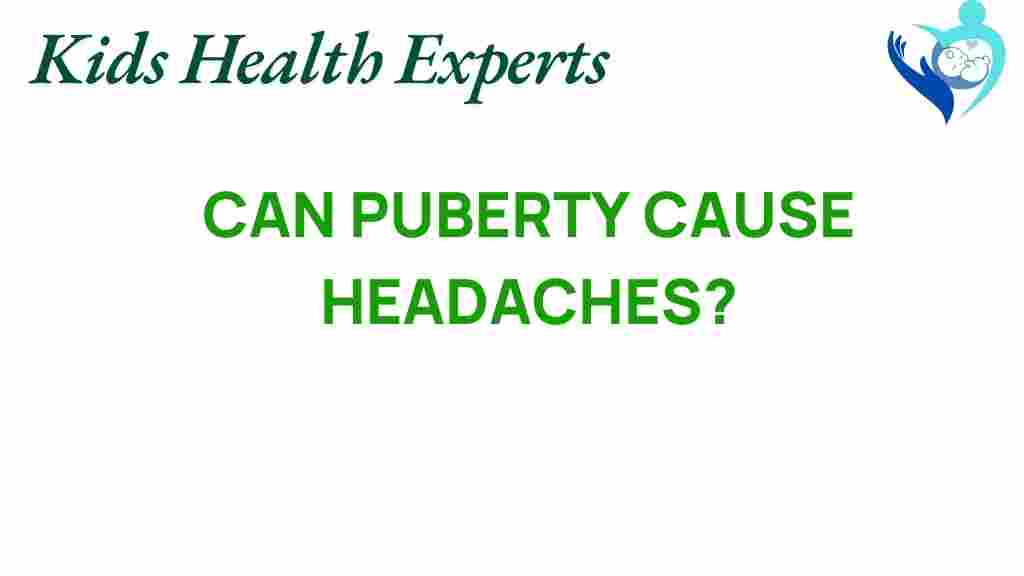Unraveling the Mystery: Can Puberty Cause Headaches?
Puberty is a significant period in an individual’s life, marked by various physical and emotional changes. As adolescents transition from childhood to adulthood, they face numerous challenges, including the onset of headaches. Understanding the connection between puberty and headaches is crucial for parents, educators, and teens themselves. In this article, we will explore the relationship between puberty, hormonal changes, and the emergence of headaches, particularly focusing on migraine triggers and teen health.
Understanding Puberty and Its Impact on Health
Puberty typically occurs between the ages of 9 and 14 for girls and 10 to 15 for boys. This phase involves a surge in hormones, which significantly affect both physical and emotional well-being. The hormonal changes can lead to various adolescent challenges, including mood swings, growth spurts, and, notably, headaches.
The Hormonal Connection
During puberty, the body produces increased levels of hormones such as estrogen and testosterone. These hormonal fluctuations can affect neurotransmitters in the brain, potentially leading to headaches. Here are several key points about how these hormonal changes can trigger headaches:
- Estrogen Levels: For females, estrogen levels fluctuate significantly during the menstrual cycle, which can trigger migraines. This connection between estrogen and headaches is well-documented.
- Testosterone Levels: In males, rising testosterone levels can also lead to increased headache frequency as their bodies adjust to new hormonal balances.
- Stress Hormones: Adolescence is often a stressful time, and stress hormones can further exacerbate headache conditions.
Types of Headaches Common in Adolescents
Headaches in adolescents can manifest in various forms. Understanding these types can help in identifying the cause and seeking appropriate treatment.
- Tension Headaches: These are the most common type. They often result from stress, anxiety, or muscular tension.
- Migraines: Characterized by intense pain, nausea, and sensitivity to light and sound, migraines are often linked to hormonal changes during puberty.
- Cluster Headaches: Although less common, these can occur and are marked by severe pain on one side of the head.
Identifying Migraine Triggers in Adolescents
For many teens, migraines can be debilitating. Recognizing migraine triggers is essential for managing headaches effectively. Common triggers include:
- Hormonal Changes: As mentioned, fluctuations in hormones can lead to migraine attacks.
- Diet: Certain foods and drinks, such as aged cheeses, chocolate, and caffeine, can trigger migraines.
- Sleep Patterns: Irregular sleep schedules or insufficient sleep can lead to increased headache occurrences.
- Stress: Emotional stress is a significant trigger for many adolescents.
Step-by-Step Process to Manage Headaches During Puberty
Managing headaches during puberty requires a systematic approach. Here’s a step-by-step process that can help:
Step 1: Keep a Headache Diary
Documenting headaches can help identify patterns and triggers. Include the following in the diary:
- Date and time of the headache
- Duration and intensity of the pain
- Possible triggers (food, stress, sleep, etc.)
- What alleviated the headache
Step 2: Consult a Healthcare Professional
It’s essential to consult a healthcare provider if headaches become frequent or severe. A professional can help diagnose the type of headache and recommend appropriate treatments.
Step 3: Implement Lifestyle Changes
Making certain lifestyle adjustments can significantly reduce headache frequency:
- Maintain a Regular Sleep Schedule: Aim for 8-10 hours of sleep each night.
- Stay Hydrated: Drink plenty of water throughout the day.
- Eat Balanced Meals: Focus on a diet rich in fruits, vegetables, whole grains, and lean proteins.
- Manage Stress: Engage in relaxation techniques such as yoga, meditation, or deep breathing exercises.
Step 4: Consider Medication
If lifestyle changes are insufficient, medication may be necessary. Over-the-counter pain relievers like ibuprofen or acetaminophen can be effective for mild headaches. For more severe cases, a doctor may prescribe migraine-specific medications.
Troubleshooting Common Headache Issues in Teens
Even with preventive measures in place, headaches can still occur. Here are some troubleshooting tips to consider:
Recognizing Warning Signs
Teens should be aware of specific symptoms that may indicate a more severe condition, such as:
- Headaches that worsen over time
- Visual disturbances or aura before headaches
- Headaches accompanied by fever or a stiff neck
- Headaches that disrupt daily activities
When to Seek Immediate Help
In certain situations, immediate medical attention is necessary. Seek help if:
- The headache is sudden and severe
- There are neurological symptoms, such as confusion or weakness
- Headaches are accompanied by seizures
Conclusion: Supporting Teen Health During Puberty
Understanding the connection between puberty and headaches is vital in supporting adolescent health. While hormonal changes during puberty can lead to increased headache frequency, identifying triggers and implementing effective management strategies can significantly improve a teen’s quality of life. It’s essential for parents and caregivers to provide support and encourage open conversations about health challenges during this critical developmental stage. For more insights into managing adolescent health issues, consider visiting the Teen Health Resources.
By being proactive and informed, both teens and their families can navigate the complexities of puberty and minimize the impact of headaches on daily life.
This article is in the category Conditions and created by KidsHealthExperts Team
